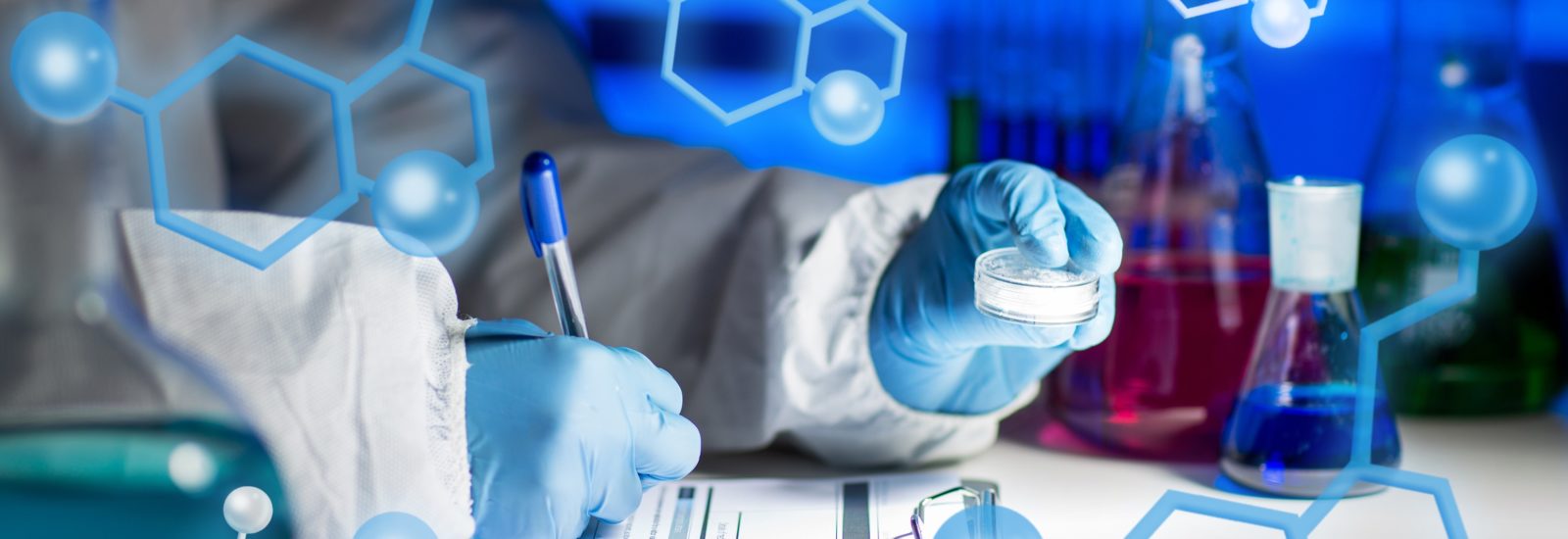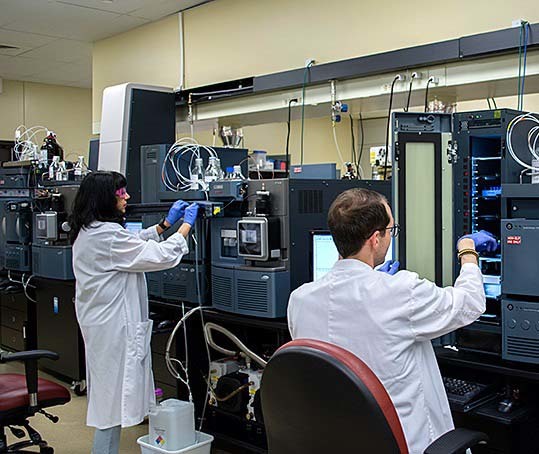
In Vitro Microsomal and Plasma Protein Binding Assay Capabilities
Our definitive in vitro Microsomal and Plasma Protein Binding (MPB & PPB) assays use Equilibrium Dialysis to determine free drug concentration (fraction unbound, fu) in plasma or in the presence of microsomes, which can be a necessary input for several PK-related calculations, modeling, and design of definitive IND-enabling in vitro and in vivo studies.
Understanding the amount of protein binding is critical to developing the drug metabolism and pharmacokinetics (DMPK) profile of a xenobiotic as well as potential for drug-drug interactions (DDI). Fraction of unbound drug (fu) represents the percentage of drug compound not bound to plasma or microsomal proteins and is, therefore, free to exert intended therapeutic effect; protein binding consideration is, therefore, of high importance in understanding how a drug may be distributed within and cleared from the body.
It is important to understand how a drug candidate binds to proteins in plasma. Data from a plasma protein binding study can inform:
- Distribution into tissues of the body
- Therapeutic effects of drug
- Reduction in the amount of drug available to be metabolized or cleared from the body
Data from a microsomal protein binding study can also be used to calculate unbound Ki values for modeling:
- Ki adjusted for fumcs: Ki,u = fumcs × IC50 / 2

Regulatory Guidance Regarding PB Data for Successful New Drug Applications
Human protein binding (plasma and microsomal) is also important information that can be used in the design of IND-enabling studies outlined in guidance from FDA, EMA and PMDA (e.g., the M3(R2) Guidance for Industry: Nonclinical Safety Studies for the Conduct of Human Clinical Trials and Marketing Authorization for Pharmaceuticals states, “In vitro metabolic and plasma protein binding data for animals and humans and systemic exposure data in the species used for repeated-dose toxicity studies generally should be evaluated before initiating human clinical trials.”) Find out more about regulatory expectations for PB and other in vitro IND-enabling studies on our How We Help page, “What studies do I need for a successful IND/NDA?”
Regulatory guidance strongly emphasizes evaluating physiologically relevant concentrations of drug, which means that the fraction of drug unbound in circulation should be considered.
Avoid Inaccuracy
Factors determining fu are comprised of a drug’s affinity to a protein, concentration of plasma or microsomal protein, and concentration of a drug relative to protein. Neglecting to quantify the fu of a compound accurately with a definitive study can translate to misinformed dose determination. Even a small inaccuracy can mean a big difference if the drug has high PB, which is categorized by a binding affinity of greater than 99%. Knowing whether your drug is 98.9% or 99.8% bound can de-risk changes in free drug exposure, which can impact in vivo studies.
Our Approach to Microsomal and Plasma Protein Binding Assays
Options for Test System
- Plasma (PPB – Plasma Protein Binding)
- Microsomes (MPB – Microsomal Protein Binding)
What you get from a typical XenoTech in vitro protein binding study:
- Preliminary evaluations of stability, non-specific binding potential, and time to equilibrium
- Main experiment to accurately determine fraction unbound (fu) in plasma (or in the presence of microsomes) using rapid equilibrium dialysis (RED)
- Full report detailing methods, data, and results/conclusions
Equilibrium Dialysis
Our standard study design utilizes the equilibrium dialysis method by using the Rapid Equilibrium Dialysis (RED) device. Equilibrium dialysis is a technique in which free drug in plasma (or in the presence of microsomes) is allowed to reach equilibrium across a semipermeable membrane. Drug is added to one chamber containing plasma or microsomes and allowed to reach equilibrium across the membrane into a chamber with buffer. Following incubation of the RED device at 37° C, aliquots are removed from both chambers at the appropriate time points, and the amount of drug in each chamber is measured by LC-MS/MS or other appropriate method.
Standard Assay Design
Our standard study design consists of two phases: 1) a preliminary evaluation used to optimize the assay for the compound being tested and 2) the experiment measuring plasma (or microsomal) protein binding. The following parameters are evaluated in the preliminary evaluation in duplicate for each drug tested:
- Equilibrium time: This is the time needed to allow free drug to reach equilibrium across the dialysis membrane
- Stability: Plasma and microsomes contain drug metabolizing enzymes; therefore, the drug must be stable enough in these test systems to allow measurement of free concentration.
- Non-specific binding: Drugs that are very hydrophobic may nonspecifically bind to the dialysis membrane and/or the chambers of the device.
These data are used to optimize experimental conditions for the drug being tested prior to measurement of protein binding. ‘Stability’ typically refers to the interaction of test article with enzymes in the plasma/microsomes or chemical degradation, which could result in decreased concentrations and make it difficult to accurately determine PB. Non-specific binding and time to equilibrium are evaluated in buffer to inform the impact of non-specific binding to the apparatus and determine the appropriate incubation time that should be utilized for the evaluation of PB in the main experiment.
While it may be important to understand how plasma protein binding impacts free concentrations of drug in humans, it can also be important to understand the differences in plasma protein binding for common preclinical species. We also offer plasma protein binding assessment for other common preclinical species such as mouse, rat, dog and monkey. Other species may be available on request. Microsomal Protein Binding is only available with microsomes derived from human hepatocytes.
In Vitro PB Study Results
Once the appropriate conditions have been identified, the fraction unbound will be measured in triplicate. For plasma protein binding, the positive control, warfarin, is also quantified along with that of the drug candidate, whereas with microsomal protein binding paroxetine is used as the positive control. Depending on the results from the preliminary evaluation, for PB it may be determined that an alternate method such as ultrafiltration or ultracentrifugation may be needed, which can be performed through our partners at the Drug Development Solutions Center, in Tokai, Japan.
Additional Methods Available through the Drug Development Solutions Center
- Ultra-filtration
- Ultra-centrifugation
Related Services:
In Vivo Plasma Protein Binding (PPB)
In vivo Plasma Protein Binding (PPB) studies are also available to determine free drug concentration in plasma from treated animals or human plasma using radiolabeled or unlabeled compound.
Screening Study: Plasma Protein Binding (PPB)
Discovery Plus™ Screening Suite presents medium-throughput alternatives to definitive metabolism & DDI studies through non-GLP, abbreviated versions of our definitive assays. This option is best used for comparison of multiple compounds or to yield preliminary data for definitive in vitro studies. Our medium-throughput screening service uses Rapid Equilibrium Dialysis to measure fraction unbound (fu), non-specific binding (% recovery) and the plasma stability (% remaining) of your compound. The study design allows evaluation of up to 15 compounds (plus a positive control) at a single concentration dialyzed against buffer at 37°C for four hours, with plasma from up to six different species and relative quantitation analysis by LC-MS/MS.

